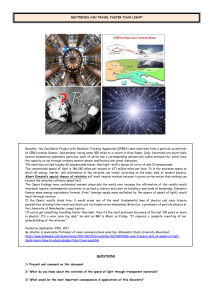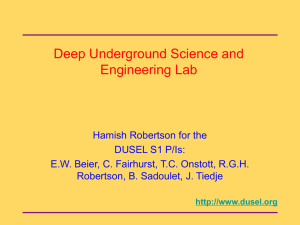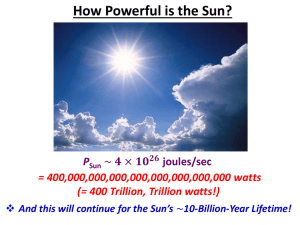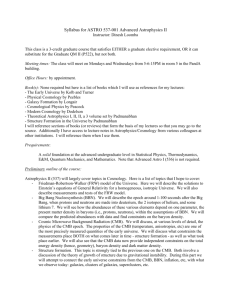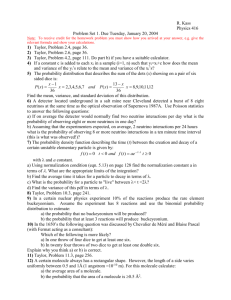PHY418 Particle Astrophysics - Particle Physics and Particle
advertisement
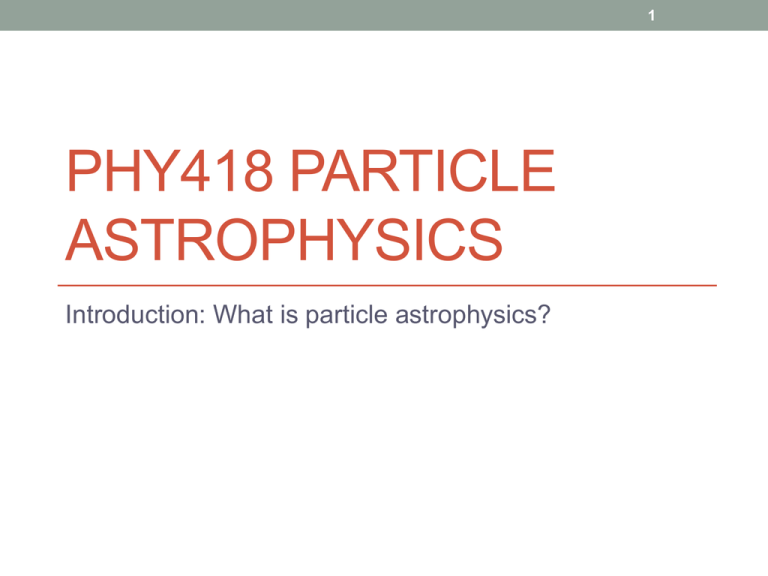
1 PHY418 PARTICLE ASTROPHYSICS Introduction: What is particle astrophysics? 2 What is particle astrophysics? • Particle astrophysics is the use of particle physics techniques (experimental or theoretical) to address astrophysical questions. • Topics included: • early-universe cosmology • inflation (and alternatives), baryogenesis, dark energy • cosmic rays • γ-ray astronomy • high-energy neutrino astronomy These form a coherent field with a lot of common factors—“highenergy particle astrophysics” • low-energy neutrino astronomy • dark matter (see PHY326/426) • I will focus on high-energy particle astrophysics 3 PHY418 Syllabus • Introduction • brief outline of those topics I am not going to cover in detail • High-energy particle astrophysics: the observations • cosmic rays • radio emission • high-energy photon emission (X-rays and γ-rays) • neutrinos • Acceleration mechanisms • Fermi second-order • diffusive shock acceleration • magnetic reconnection • Sources • case studies of the principal source types 4 PHY418 Resources • There isn’t an ideal course text—so I have basically written one • too long to photocopy for you (and not finished yet!) but you can download the pdf from the website • www.hep.shef.ac.uk/cartwright/phy418 • this will also contain copies of slides (when they exist…) • The nearest thing to a “proper” course text is Malcolm Longair, High Energy Astrophysics 3rd edition, CUP • several copies in IC • different organisation and emphasis compared to course • rather more detail in the mathematics • it is in SI units—note that a lot of texts at this level are in cgs 5 PHY418 Assessment • Mainly the end-of-semester exam (85%) • One compulsory question (30 marks) • Any two from four optional questions (20 marks each) • A practice exam will be provided since this is a new module • Also short class tests (15%) • similar to those in PHY320—designed to test your knowledge of the taught material • probably 5 (one after each section in Observations, and one after Acceleration Mechanisms) • open notes format 6 INTRODUCTION TO PARTICLE ASTROPHYSICS Early-universe cosmology 7 Early-universe cosmology • In the early universe, energies are extremely high • appropriate physics is very high-energy particle physics • GUTs, string theory?? • consequences in early universe • inflation (breakdown of GUT?) • baryogenesis (matter-antimatter asymmetry) • consequences in later universe • dark energy (vacuum energy? scalar field?) • dark matter (lightest supersymmetric particle? axion?) • Particle physics of early universe is very difficult to test • energies are much too high for feasible accelerators 8 notes section 1.2.1 Inflation • Observational evidence shows that the universe is • geometrically flat (k = 0 in Robertson-Walker metric) • extremely uniform at early times (ΔT/T ~ 10−5 in CMB) • not precisely uniform (with nearly scale invariant fluctuations) • These properties are unexpected in the classical Big Bang model • no reason in GR why overall geometry should be flat • and if it is not flat originally it evolves rapidly in the direction of increased curvature • no expectation that the CMB temperature should be uniform • horizon distance expands faster than universe, so causally connected regions at ~400000 years correspond to only ~2° on sky now • if initial conditions force it to be uniform, no explanation for the fact that it is not quite uniform 9 Inflation • Observational features can be accounted for by inflation • period of very fast (~exponential) expansion in very early universe • expansion 𝑎 ∝ 𝑒 𝐻𝑡 or 𝑎 ∝ 𝑎𝑛 , n > 1, will force geometry towards flatness and ensure that visible universe is causally connected • quantum fluctuations provide the anisotropies • with the right spectrum 10 Inflation and the inflaton • Exponential expansion requires equation of state P = −Ɛ (vacuum energy) • this can be approximated by a scalar field (the inflaton) ϕ: 1 𝜙+𝑉 𝜙 ; 3 2ℏ𝑐 1 𝑃𝜙 = 𝜙−𝑉 𝜙 ; 2ℏ𝑐 3 ℰ𝜙 = • if the kinetic term is small this is almost a vacuum energy • this is very similar to the Higgs field (but expected mass of inflaton ≫ Higgs mass) • most extensions to Standard Model (e.g. supersymmetry) predict more Higgs fields • various models of inflationary cosmology exist • testable using CMB polarisation, cf. BICEP2 11 notes section 1.2.2 Baryogenesis • The universe contains matter, but not antimatter • evidence: no annihilation signatures • The amount of (baryonic) matter is small • ratio of baryons to photons ~6×10−10 • At some point in the very early universe, non-zero baryon number must be generated • Sakharov conditions: • B must be violated • reactions must take place out of thermodynamic equilibrium • C and CP must be violated 12 Baryogenesis • B violation occurs in Standard Model • via transitions called sphalerons which conserve B – L but violate B and L separately (by 3 units) • these are quantum tunnelling transitions which are suppressed to non-existence in the present universe but would have occurred easily at sufficiently high energies • Out-of-equilibrium conditions are natural • in a rapidly expanding and cooling early universe • C and CP violation are observed in weak interactions • level of CP violation insufficient for observed asymmetry • CP violation may also occur in neutrino sector 13 Baryogenesis models • GUT baryogenesis • takes place via heavy gauge bosons X and Y • problem—may allow production of heavy GUT relics such as magnetic monopoles • Electroweak baryogenesis • takes place at electroweak phase transition (~100 GeV) • problem: requires first-order phase transition to satisfy out-of-equilibrium condition, and this requires a light Higgs (<75 GeV/c2, cf. 126 GeV/c2) 14 Leptogenesis models • Generate non-zero lepton number, convert to B via sphaleron transitions • lepton number violation is testable at low energies via double β decay • occurs if neutrinos are Majorana particles (neutrino and antineutrino are the same particle with different “handedness”) • expected in “seesaw models” which use massive right-handed neutrino to explain why (left-handed) neutrino mass so small compared to other fermions • possible link to axion dark matter • lightest of the “heavy” neutrino states could be linked to axion symmetry-breaking scale f (see later) 15 INTRODUCTION TO PARTICLE ASTROPHYSICS Dark Energy and Dark Matter 16 notes section 1.3 Dark energy • There is a great deal of observational evidence from astrophysics and cosmology that the expansion of the universe is currently accelerating • requires a component with equation of state P = wƐ where w < −1/3 (w = −1 is a vacuum energy or cosmological constant, Λ) • Vacuum energy is “natural” because of spontaneous pair creation (uncertainty principle) • but “natural” value of Λ is ~10120 times too large! 17 Models of dark energy • Vacuum energy plus weak anthropic principle • if Λ had its “natural” value, we would not exist, therefore Λ must be “unnaturally” small • works best in multiverse models such as chaotic inflation (there are then many other universes with “natural” Λ and no life) • Scalar field (as in inflation) • in this case the effective value of Λ will evolve over time • in some “tracker” models it is constrained to stay close to the density of radiation or matter • Modified gravity • especially in models with extra dimensions 18 notes section 1.6 Dark matter • Much observational evidence that most matter in the universe is (a) non-luminous and (b) non-baryonic • non-luminous: • rotation curves of galaxies • gravitational potential of galaxy clusters • weak lensing maps • non-baryonic • comparison of light-isotope abundances with gravitational mass • comparison of X-ray luminosity of clusters with gravitational potential • power spectrum of CMB anisotropies 19 Dark matter properties • From observations, dark matter must • not absorb or emit light (and hence, not interact electromagnetically) • because it is not seen, in emission or absorption, at any wavelength, and from CMB power spectrum which implies it does not interact with photons • not be hadronic (i.e. strongly interacting) • from discrepancy between light-element abundances and gravitational mass measurements • be non-relativistic at z ~ 3000 • so that it can be bound in galaxy-sized potential wells when structures form • be stable or very nearly so • because mass measurements in local universe agree with CMB • No Standard Model particle satisfies this list • neutrinos are closest, but are relativistic at z ~ 3000 (“hot”) 20 Dark matter candidates GHP = Gauge Hierarchy Problem; NPFP = New Physics Flavour Problem √ = possible signal; √√ = expected signal Jonathan Feng, ARAA 48 (2010) 495 (highly recommended) 21 WIMPs • Weakly Interacting Massive Particles • predicted by various extensions of the Standard Model, the most popular and widely studied being supersymmetry (SUSY) • in most variants of SUSY the lightest supersymmetric particle is absolutely stable • it is a “neutralino”, 𝜒10 (a mix of the SUSY partners of the h, H, γ and Z) • These can be detected by identifying the recoil of an atomic nucleus struck by the WIMP • SUSY neutralinos can also be detected indirectly by identifying their annihilation products from regions of high WIMP density, e.g. the centre of the Sun • it is also possible that WIMPs could be produced at the LHC and identified as missing energy/momentum (they would not interact in the detectors) 22 WIMP limits Claimed signals are inconsistent with each other and with limits from other experiments JL Feng. et al. arXiv:1401.6085 [hep-ex] 23 Axions • The axion is a hypothetical particle arising from attempts to understand why the strong interaction conserves CP • in the Standard Model there is no reason why it should do so • Axions are expected to be extremely light (μeV−meV), but are “cold” because they are not produced thermally • they arise from a phase transition in the very early universe • Unlike WIMPs, axions do couple—extremely weakly—to photons and can be detected by the Primakoff effect • resonant conversion of axion to photon in highly tuned magnetic field • this coupling is the basis of the ADMX experiment (ask Ed Daw…) 24 Axion limits 25 INTRODUCTION TO PARTICLE ASTROPHYSICS Low energy neutrino astrophysics 26 Solar neutrinos • Hydrogen fusion must involve neutrino emission: 4 1H 4He + 2e+ + 2νe • two protons get converted to two neutrons—must emit 2e+ to conserve charge, then require 2νe for lepton number • must be electron neutrinos as insufficient energy to produce μ+ or τ+ • Many routes to the final result • Q-values, and hence neutrino energies, vary 27 Solar neutrinos • Detection techniques • inverse β decay, e.g. 37Cl + νe 37Ar + e− • low energy threshold, especially on 71Ga, but no directional or energy information • electron elastic scattering, ν + e− ν + e− • sensitive to all neutrino types, but mostly νe • capture on deuterium CC: νe + d p + p + e− NC: ν + d p + n + ν • sensitive to all neutrino types • Deuterium measurement established that solar neutrinos change flavour before detection (neutrino oscillation) SNO 28 Supernova neutrinos • 99% of the energy of a core-collapse supernova comes out as neutrinos • neutronisation pulse, p + e− n + νe • thermal pair production • Verified when neutrinos detected from SN 1987A • only 24, but enough to confirm energy scale • Potential for a great deal of interesting physics in the event of a Galactic CCSN • thousands of neutrinos would be detected 29 • Particle astrophysics covers a very wide range of topics Summary You should read sections 1.2, 1.3, 1.5.2, 1.5.3 and 1.6 of the notes You should know about • • • • • • inflation baryogenesis dark energy dark matter solar neutrinos supernova neutrinos • early-universe cosmology • dark energy • dark matter • low-energy neutrino astrophysics • high-energy astrophysics • cosmic rays • radio emission from high-energy particles • high-energy photons • high-energy neutrinos • This section has summarised the first four of these • rest of course will focus on last topic 30 Next: cosmic rays • history • detection techniques • observed properties Notes section 2.2
